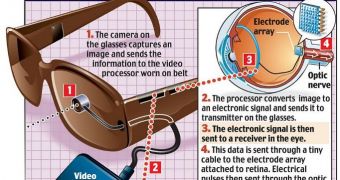Fifty-one-year-old Peter Lane is one of the first people in the world to benefit from the obvious advantages of the new bionic eye technology. The therapy relies on implanted electronics in the retina, which allow for the conversion of images collected from an external camera into electrical impulses, to be sent directly down the path of the nervous system and into the brain. The technology is, of course, still in its infancy, but the earliest results are very promising, and so investigations into it will continue at an accelerated pace, The Daily Mail reveals.
According to Lane, the implanted device has for the first time in more than 30 years of blindness allowed him to make out the contours of furniture and doorways. This may seem minor at first, but after years of bumping into things this must look like a blessing. The implants have also allowed the man to read large letters for the first time in decades. He tells that he views them through a series of dots, which is how most of the information is conveyed to his visual cortex. However, even these basic capacities are better than nothing. The Manchester, UK resident is part of a narrow study, which aims at testing the new implants before they are made widely available.
“I'm just reading small words at the moment, but it's a start. The doctors have said they'll get me a screen so I can read at home and I'm hoping I'll be able to read letters I get in the post by myself eventually. I get around inside my flat okay without the glasses because I know where everything is, but outside they give me more confidence and a bit more independence. The images I see move and that takes a bit of getting used to, but I can see cars – they look like cotton wool. It's exciting to be part of the trial,” Lane says of his new “acquisitions”. He went blind in his early 20s because he was suffering from a degenerative eye condition known as retinitis pigmentosa.
Only 32 people around the world are part of these trials, the British news outlet informs. Though major advancements have been made since this course of treatment was first proposed, experts still need to ensure that there are no lasting side-effects, and also that the brain can adapt to seeing again, after years of not exercising the visual cortex. The system is fairly simple. A camera is mounted on special glasses, which then sends a video signal to an array of sensors in the eye, which are connected to the visual nerve. These arrays bypass and replace the function of the retina, transforming video input into electrical signals, which it then sends to the brain for processing.

 14 DAY TRIAL //
14 DAY TRIAL //